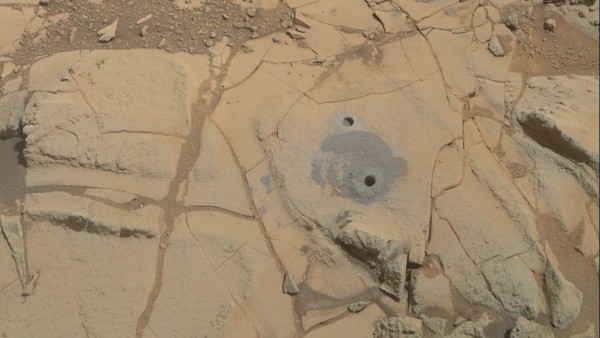NASA's Curiosity Rover Analyzes Rock Sample, Reveals Acidic Water on Mars
| Ana Verayo | | Feb 08, 2015 08:47 AM EST |
(Photo : NASA/JPL-Caltech/MSSS ) Gray cuttings from Curiosity's drilling into a target called "Mojave 2" are visible surrounding the sample-collection hole.
For the past five months, NASA's Curiosity rover has been studying and inspecting the base of Mount Sharp on Mars.
Its latest mission obtained an important sample from the mountain using a unique drilling technique. The sample came from a specific rock called Mojave 2 that apparently holds clues about the ancient Martian environmental.
Like Us on Facebook
Previously, Curiosity attempted to get samples from Mojave 2 but ended up breaking the sample, which made it impossible to deliver it to the rover's analytical scientific instruments.
What made the mission team determined to find the presence of water on Mars is mainly due to the discovery of a large amount of jarosite, a sulfate mineral that builds up in acidic environments. This site seems to expose acidic conditions as opposed to others found in different Martian drilling sites.
NASA scientists are still mulling if this acidic water was more evident at the Mojave 2 due to past environmental conditions. Did sediment build-up occurring over time form the mountain or is it that acidic water immersed the whole site?
The success in obtaining this new sample can be attributed to a new and gentler drilling method, according to John Michael Morookian from NASA's Jet Propulsion Lab. He says this is the first time that low percussion drilling tools were used on Mars to conserve energy.
Curiosity rover originally used a drill consisting of a hammer and a chisel. The rate of the drilling was adjusted so as not to hammer too hard on rocks.
Scientists, however, found out that when Curiosity obtains rock samples, it uses so much force it shatters the rocks. This new algorithm uses a slow, steady pace at a low percussion level. Curiosity spent 10 minutes drilling some 2.6 inches into the soft Mojave 2 rock.
After this successful mission, the rover will go on to collect other samples from other sites located at the mountain base before it traverses higher into Mount Sharp.
TagsNASA's Curiosity Rover Analyzes Rock Sample, Reveals Acidic Water on Mars, NASA, Mars, Curiosity Rover, Water on Mars, NASA curiosity rover acidic water rock sample, mars mount sharp, mars exploration, life on mars
©2015 Chinatopix All rights reserved. Do not reproduce without permission
EDITOR'S PICKS
-

Did the Trump administration just announce plans for a trade war with ‘hostile’ China and Russia?
-

US Senate passes Taiwan travel bill slammed by China
-

As Yan Sihong’s family grieves, here are other Chinese students who went missing abroad. Some have never been found
-

Beijing blasts Western critics who ‘smear China’ with the term sharp power
-

China Envoy Seeks to Defuse Tensions With U.S. as a Trade War Brews
-

Singapore's Deputy PM Provides Bitcoin Vote of Confidence Amid China's Blanket Bans
-

China warns investors over risks in overseas virtual currency trading
-

Chinese government most trustworthy: survey
-

Kashima Antlers On Course For Back-To-Back Titles
MOST POPULAR
LATEST NEWS
Zhou Yongkang: China's Former Security Chief Sentenced to Life in Prison

China's former Chief of the Ministry of Public Security, Zhou Yongkang, has been given a life sentence after he was found guilty of abusing his office, bribery and deliberately ... Full Article
TRENDING STORY

China Pork Prices Expected to Stabilize As The Supplies Recover

Elephone P9000 Smartphone is now on Sale on Amazon India

There's a Big Chance Cliffhangers Won't Still Be Resolved When Grey's Anatomy Season 13 Returns

Supreme Court Ruled on Samsung vs Apple Dispute for Patent Infringement

Microsoft Surface Pro 5 Rumors and Release Date: What is the Latest?










